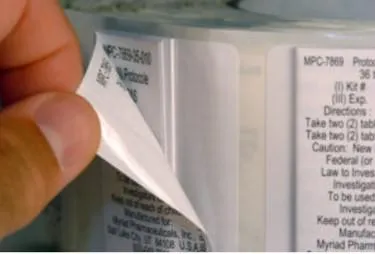When it comes to the choice of whether you're going to go with a pneumatic, electric labeler, or hybrid, marketing brochures and whitepapers would tell you that electric is the most modern and the best way to drive efficiency. While it seems advantageous to do away with compressed air and improve some efficiencies, there are some downsides to electric when compared against pneumatic models today. In this blog we will focus on the core elements of the print and apply process, and how the two different methods vary in implementation, differ in effectiveness and application range, as well as their energy efficiency.
Let's look at the key differentiation areas between electric systems and air at each stage of the process.
Air Assist
Purpose
Competitors might call it by other names, but the portion of the system responsible for getting the label from the printer to the tamp pad is referred to as the air assist or assisting blow. This is used only during the time that the label is being dispensed from the printer for the purposes of combating the label's natural curl to peel away from the system.
Using this momentary blast of air, the label is directed towards the tamp pad where the vacuum will take over and hold the label until application. This piece is only really necessary when the system is a tamp or actuated type of movement.
For systems that do a direct wipe or a roller apply, usually you will not see an air assist, as the label will be fed directly towards the product and a roller or brush will be used to merge the label to the product. We'll look at that method separately.
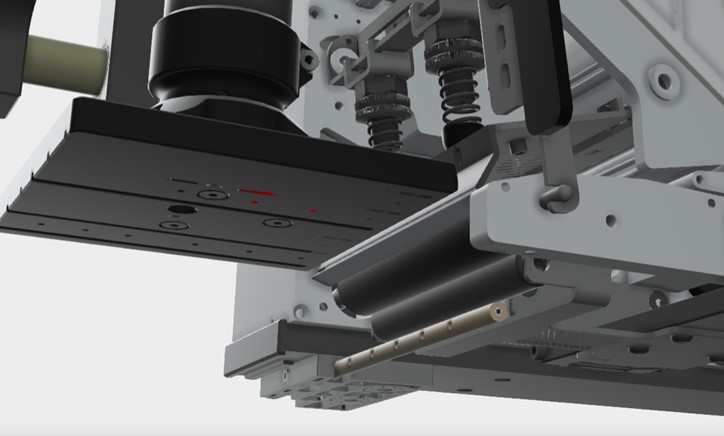
Print & Apply Technology Methods of Operation
On a pneumatic system, the air assist is driven by a high pressure valve that is directed through a hose to a metal tube that is ported with air holes all in a line across the width of print. This is designed to blow the label up to the pad to make solid contact while the vacuum is beginning to hold the label in place.
On an electric system, the air assist is typically a small squirrel cage fan or another similar type fan. They can be compact and size and still project enough airflow to help the label to the pad.
On a hybrid system, typically the air assist is done as a pneumatic function, since it is not possible to get high pressure air out of an electric fan.
Considering that this impacts the distance that the machine can be placed to the line, which overall impacts the throughput the system can achieve, it's extremely important to have the lowest profile solution. This will be an interference between machine and the line due to its location.
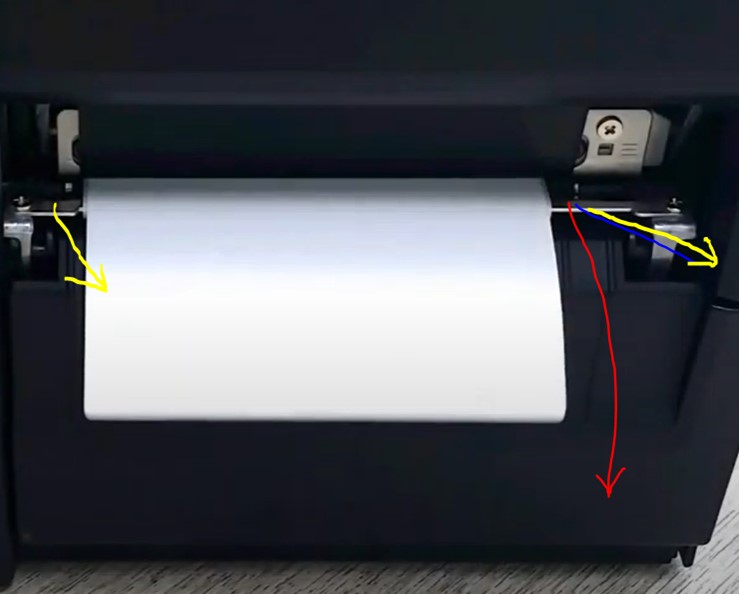
Label Effectiveness and Range
When it comes to the effectiveness in range that one can expect from pneumatic versus electric, there are large differences. The two main problem children of labeling are short labels and long labels.
Short labels are typically labels that are one inch or less and long labels are typically over 8 inches. Short labels tend to be very springy and have less surface area for guiding and directing the label when it's under the transition from the printer to the pad.
Long labels have the issue of surface friction and static resisting their movement to glide out over the tamp pad and be held in position by the pad vacuum.
In this area, the pneumatic has a solid advantage.
The high pressure and focused air stream can handle the range of normal label lengths, as well as cover the width of the label. The observed difference will be seen on the number of label jams at the printer and the number of labels that fall from the system before the product arrives.
For longer labels, label memory is a big issue. Label rolls are wrapped layers of a top material component, typically paper, an adhesive layer, a release layer, and a liner back up strip. When all sandwiched together and then wrapped in circles, the labels start to take the shape of the curvature of the roll.
One would hardly notice this at the beginning of a label roll as the roll wraps are not as tight, but as you get down to the core of the roll the curvature is much more pronounced and the labels, if left to relax without constraint, would be curved.
This makes getting labels out to the pad even more difficult, because even more air assist is needed to keep these long curved labels found towards the core flat on the pad. An electric system has its greatest struggles with longer labels that have label memory. There is simply not enough pressure to keep the label flat to the pad, and as a result the labels fall away from the pad before the vacuum can hold them in place.
For these reasons, many of the electric systems on the market today are hybrid, meaning that this portion is still pneumatic, while the actuation is electric.
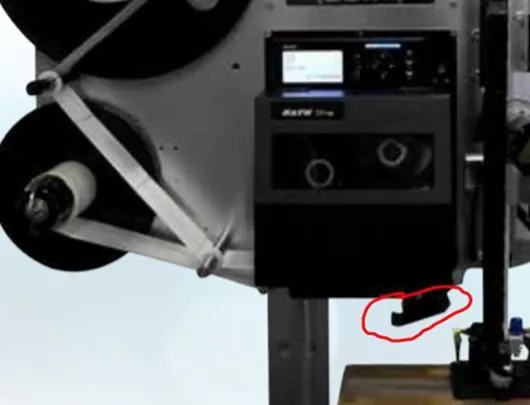
Machine Efficiency: Perception vs. Reality
Efficiency here comes down to two measures. One is how much energy is needed to get the label to the pad and the other is the yield for labels making it to the product for application.
For very short labels, very little compressed air is used to drive the air assist. Air assist is only used during the time the label is printed, so in most cases this is only being turned on for around a second or two.
With the electric system, there is very little energy that is used, but the effectiveness is much less, resulting in reworks or adding redundant systems to ensure 100% labeling compliance.
Conclusion
Only focusing on labeling systems with actuators, the air assist function is largely responsible for three attributes:
- Ensuring the label is transferred from printer to tamp pad
- Making sure the label is fed flat, without any buckles or wrinkles
- How well it is directed to the pad determines how accurately the label will be placed on the product
Electric systems have difficulty providing a high pressure airflow across the width of the label and in a form factor that allows for the closest positioning of the machine to the line, which is critical for higher throughput rates.
While electric air assist systems perform the job, they don't perform it as well or as effectively as a pneumatic system. There will be a slightly higher cost associated with the using compressed air for vacuum versus the electric equivalent, but in terms of performance and effectiveness, the two are not equal.
There is a clear advantage with the pneumatic air assist.
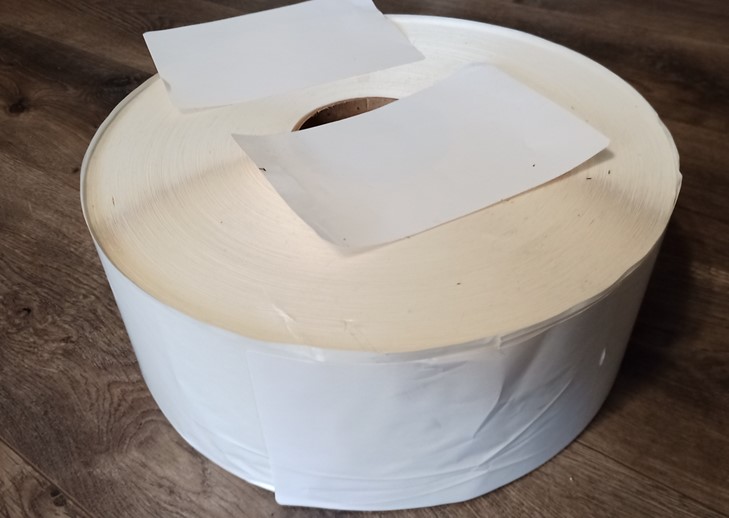
Vacuum Label
Purpose
Before the label can be applied to the surface of the product, it needs to be held secure for its transit time to the product. In some applications, the label may be forced to sit on that tamp pad for some amount of time until it's ready for application.
Method of Operation
On an electric system, there are a few different ways that a label can be held in place by vacuum. One method is to provide vacuum only when the label is in the home position, before application. Another method is to provide vacuum for not only the home position, but while the label is in transit to the product.
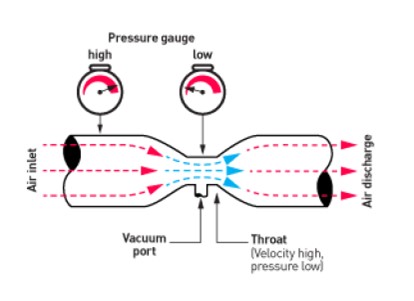
Having the label under vacuum control throughout its transit time to the product can be not only advantageous, but a requirement for the industry or application where it's used. It's generally an accepted best practice to have vacuum control on the label throughout the process, as there can be times where there is a false trigger and the system goes to apply the label, detects no presence of product, and then will need to return with the label on the pad (not the floor or conveyance).
The electric system employs fans to generate static pressure to hold the label in place. This is very similar to how a sheet of paper can be held up against the air intake side of a house box fan and be held in place. This method works well for labels with large surface area but far less effective for small labels.
On a pneumatic system, the compressed air is sent through a valve that is then connected to a venturi, which creates vacuum through an input of high pressure. the vacuum port of the venturi is then filtered and passed through a hose to the tamp pad to create label hold.
Effectiveness and Range
Pneumatic generated vacuum allows for the greatest holding force, the widest range of label sizes, and it's extremely durable, as the vacuum generating portion is free from moving parts.
Tamp pad design considerations, such as large internal channels of the electric fan pads effects the durability of the pad. Often, to get enough air flow with an electric fan, the pad face and rear surfaces have large voids in the in-between layers. That creates stresses and cracks that eventually destroy the pad.
Efficiency
When it comes to efficiency, pneumatic systems get a bad rap, especially when it comes to vacuum. The reason why most comparisons between pneumatic and electric systems clearly show an advantage for electric in terms of efficiency for cost, is because the comparisons are done with vacuum running throughout the entirety of the application. In real world applications, it is a poor practice to have a label generated and dispensed out to the pad before it is absolutely needed. If the label has to remain waiting on the pad for application, the adhesive will begin to dry as well as compressed air will be consumed two hold the label in place.
Worse still, is when the information on the label contains product specific detail or a time and date component. If the label is generated long before it may be applied, it may have the wrong product information, as a batch changeover could occur. It could have the wrong date and shift code, or it could simply have very ineffective mostly dried adhesive resulting in a label that doesn't attached to product but does end up on the conveyance or ground.
In order to make a pneumatic system more efficient and more in line with best practice setups, the label would only be generated “on demand" so that the label is created just in time before the application moment.
Conclusion
If a comparison is made solely against a poorly designed and poorly implemented pneumatic system versus a new designed electric system, then the electric system would clearly have the advantage in efficiency but not in overall effectiveness.
When it comes to label hold, the pneumatic system is going to have much more holding force then in electric equivalent. The pneumatic system is going to excel in the areas of versatility in label dimensions, the types of labels that can be held in place such as piggyback labels or booklets, and most importantly, in the durability and reliability for everyday use.
In regards to overall operations costs, the electric system will need to keep the fan running throughout the duration that the system is online, whether it's applying labels or sitting idle. The time it takes for an electric fan to spin up and the generate the necessary static pressure to hold the label is too long to only begin the label is first being dispensed. Since the labeling system has no knowledge of when the next product is coming, it must always be running the fan in the event a label feed will take place.
